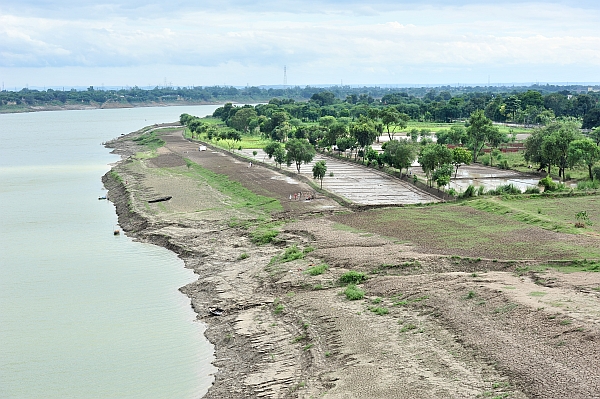The Ganges can be an engine for sustainable development
There can be few rivers as revered as the Ganges. From its source in the Himalayas to its intricate delta in Bangladesh, it holds a spiritual power that transcends the many borders that it crosses. But despite its elevated status, the river is not in good shape. Beset by pollution, surrounded by communities living in extreme poverty, its status as a holy river is sometimes hard to appreciate.

Photo: Neil Palmer/IWMI
Nevertheless it remains the lifeblood of a great swathe of land from Nepal, through Northern India and on to the sea. Agriculture in this region supports millions, but rarely is it productive enough to pull farm families out of poverty. The highly seasonal nature of rainfall in South Asia means that most smallholders can only grow a single crop per year.
That is not because there is not enough water flowing through the basin – far from it. On an annual basis there is enough water in the system to boost agricultural output whilst still leaving enough for cities, industry and natural assets like wetlands. But the extreme seasonality of water availability means that much of it goes unused.
To remedy the situation, a fresh approach is needed. A new research report from IWMI argues that if the river basin can be turned into a “machine” for capturing and releasing water it could transform livelihoods, whilst still supporting the natural environment.
“The idea for turning the Ganges basin into a “water machine” is not new, but the need to harness its productive power is increasingly urgent,” says IWMI’s Upali Amarasinghe, one of the report’s authors. “The severe drought in parts of India this year has reminded us all that climate variability is likely to increase. Only by capturing, storing and sustainably using Ganges water in new and innovative ways can we hope to maintain food security for local communities and address issues of persistent rural poverty.”
To help realize this vision, the authors have analyzed the available data and crunched the numbers to make a convincing case for the viability of this approach.
Making better use of groundwater both as a store and as a renewable resource is at the heart of the proposition. Many Ganges Basin farmers already rely on underground aquifers during the dry part of the year. Indeed, more than three quarters of the water used in the basin for irrigation, domestic services and industry comes from groundwater withdrawals. This reliance on groundwater is likely to increase further as, in a densely populated landscape, there are limited prospects for developing additional surface water stores like reservoirs and ponds.
On the face of it, this looks like an impending disaster of depleted water tables and increased pumping costs. But, say the authors, the data suggest that it doesn’t have to be this way. If excess monsoonal water could be persuaded to percolate underground, rather than flowing on to the sea, then there would be sufficient storage in decades to come – despite rapidly growing populations. This could be encouraged using simple tested technologies such as recharge wells.
In the Ganges machine model additional sub-surface storage is created by accelerated use of groundwater prior to the onset of the monsoon season. Once the rains start, aquifers are recharged using monsoon surface runoff. This cycle of withdrawal and replenishment becomes the “machine” that stores water when it is in abundance and allows it be used in times of scarcity.
“There is a potential unmet water demand of up to 125 Bm3/year that exists under different scenarios of irrigation water use,” says Amarasinghe. “However, because of supply constraint the realizable potential at present is between about half that. This varies depending which part of the basin you look at.”
The authors also looked at the costs of creating a water machine and discovered that it is a financially viable intervention with a benefit to cost ratio of over 2.3. However, the actual realization of its potential depends on many other hydrological and socio-economic factors.
For instance, in the past a lack of access to pumps and the energy needed to run them would have made the machine concept virtually unworkable. But the advent of solar powered pumps could change all that. This would be financially more viable than using diesel for groundwater pumping as practiced in many areas now, but start-up costs are still prohibitively high for many farmers. Other related challenges including availability of land for recharge structures, and people’s willingness to increase cropping intensity beyond the present level.
Regardless of the constraints above, the benefits of developing only a small portion of such potential storage are likely to be enormous. Besides irrigation benefits, the machine approach can buffer rainfall variability and reduce extreme flooding, especially in downstream regions. Sub surface storage can also be used to increase river flow during the low-flow months to keep ecosystems healthy.
“While this may be not a panacea for water availability and scarcity issues throughout the Basin,” says Amarasinghe, “The Ganges Water Machine can surely help alleviate these issues in parts of the Ganges, and needs to receive more attention now than it did in the past.”
Amarasinghe, U. A.; Muthuwatta, L.; Smakhtin, V.; Surinaidu, L.; Natarajan, R.; Chinnasamy, P.; Kakumanu, K. R.; Prathapar, S. A.; Jain, S. K.; Ghosh, N. C.; Singh, S.; Sharma, A.; Jain, S. K.; Kumar, S.; Goel, M. K. 2016. Reviving the Ganges water machine: potential and challenges to meet increasing water demand in the Ganges River Basin. Colombo, Sri Lanka: International Water Management Institute (IWMI). 42p. (IWMI Research Report 167). doi: 10.5337/2016.212
This research was carried out as part of the CGIAR Research Program on Water, Land and Ecosystems (WLE) and supported by CGIAR Fund Donors.

